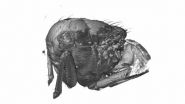(Press-News.org) PROVIDENCE, R.I. [Brown University] — In life, many tasks have a context that dictates the right actions, so when people learn to do something new, they'll often infer cues of context and rules. In a new study, Brown University brain scientists took advantage of that tendency to track the emergence of such rule structures in the frontal cortex — even when such structure was not necessary or even helpful to learn — and to predict from EEG readings how people would apply them to learn new tasks speedily.
Context and rule structures are everywhere. They allow an iPhone user who switches to an Android phone, for example, to reason that dimming the screen would involve finding a "settings" icon that will probably lead to a slider control for "brightness." But when the context changes, inflexible generalization can lead a person temporarily astray — like a small-town tourist who greets strangers on the streets of New York City. In some developmental learning disabilities, the whole process of inferring abstract structures may be impaired.
"The world tends to be organized, and so we probably develop prior [notions] over time that there is going to be a structure," said Anne Collins, a postdoctoral scholar in the Department of Cognitive, Linguistic, and Psychological Sciences at Brown and lead author of the study published March 25 in the Journal of Neuroscience. "When the world is organized, you just reduce the size of what you have to learn about by being able to generalize across situations in which the same things usually happen together. It is efficient to generalize if there is structure, and there usually is structure."
Imagined rules
To measure how the phenomenon plays out in the brain, Collins and her colleagues used arrays of EEG electrodes to record the frontal cortex activity of 35 volunteers while they learned and performed some seemingly simple tasks. All subjects had to do was look at some shapes of different colors and learn the correct buttons to punch in response. Then they moved on to two similar tasks with new sets of colors or shapes.
The experimental trick was that there was no actual structure of context and rules to the original task: People could have just learned which button to press for each unique combination of color and shape. People were free, however, to assume instead that either the dimension of color or shape would signify a particular context for indicating how to act in response to the other dimension. This invented hierarchical structure would allow them to learn the initial task, but the experiment was designed so that learning it in this way would help make learning subsequent tasks easier in some conditions (those that shared the same structure as seen previously) and harder in others.
On the whole, participants tended to infer a rule structure, with about half of them (18 of 35) imagining rules dictated by the context of color, while the other half assumed rules based on the context of shape.
Tangible signals
With these behavioral results, the researchers could then look at the EEG data recorded at the same time and search for activity related to the formation of these rule structures in regions of the frontal cortex. They informed their investigation with a computational model of cognition that predicted the following pattern: Subjects will first formulate their idea of the task's structure in the prefrontal cortex (closer to the forehead), and later formulate the movement plan to press the presumed correct button in a part of the brain a little further back (the premotor cortex).
The EEG readings confirmed this prediction with precise correlations between the timing (and less precisely the locations) of the brain activity and behavior.
The researchers were able to determine from the EEG readings – not just from the behavioral results – which context subjects were imagining: shape or color.
Individual variation
Not everyone was the same. People showed significant individual variation. The extent of structure forming activity in the brain correlated with the extent to which people applied the structure they imagined to the subsequent tasks.
"There are predictable signatures in the neural data that showed if their brains seemed to be representing the structure in the way that we would predict from our models and the behavioral experiments, then they were more likely to be able to use that when it's helpful afterwards in novel environments," said Michael Frank, associate professor of cognitive, linguistic, and psychological sciences and the paper's corresponding author. "There is something to the organization of the prefrontal cortex that facilitates looking for those structures and the ability to generalize them."
The study offers new information about the basic neuroscience of cognition and learning, but Frank also hypothesizes that the findings could be valuable if applied to the study of learning disabilities.
"So far we've only studied young, healthy people, but there is some potential for using the variance across individuals in the tendency to discover structure and for their brains to be looking for that — [the potential] to understand what happens in some disorders where people often won't think in more abstract ways that allow them to generalize their behaviors," Frank said.
INFORMATION:In addition to Collins and Frank, the paper's other author is James Cavanaugh, a former Brown postdoctoral researcher who is now a professor at the University of New Mexico.
The National Institutes of Health and the National Science Foundation supported the research.
EEG study shows how brain infers structure, rules when learning
2014-03-25
ELSE PRESS RELEASES FROM THIS DATE:
In-fly movie: 3D video from inside flying insects
2014-03-25
VIDEO:
This is a 3D movie of a blowfly's flight muscles moving created by Oxford University and Imperial scientists using a new X-ray scanning technique.
Click here for more information.
The flight muscles moving inside flies have been filmed for the first time using a new 3D X-ray scanning technique.
3D movies of the muscles were created by a team from Oxford University, Imperial College London, and the Paul Scherrer Institute (PSI), using the PSI's Swiss Light Source, ...
Strictly limiting hours surgical residents can work has not improved patient safety
2014-03-25
TORONTO, March 25, 2014--Strictly limiting the number of hours surgical residents can work has not improved patient outcomes but may have increased complications for some patients and led to higher failure rates on certification exams, a research paper concludes.
Traditionally, doctors in the residency phase of their training spent very long hours in a hospital –often around-the-clock--so they could see a wide variety and high volume of patients. In the last 10 years, health authorities started limiting those hours in the hopes of improving patient safety and the education ...
Unravelling nerve-cell death in rare children's disease
2014-03-25
LA JOLLA, Calif., March 25, 2014 — A team of scientists, led by Stuart Lipton, M.D., Ph.D., professor and director of the Neuroscience and Aging Research Center at Sanford-Burnham Medical Research Institute (Sanford-Burnham), recently discovered why cerebellar granule cell neurons in patients suffering from ataxia-telangiectasia (A-T) were unable to repair DNA damage and thus died.
A-T is a hereditary condition that begins early in childhood, and causes a gradual loss of certain nerve cells in the cerebellum of the brain. A-T occurs in about 1 in 40,000 births, with symptoms ...
Brain differences in college-aged occasional drug users
2014-03-25
Researchers at the University of California, San Diego School of Medicine have discovered impaired neuronal activity in the parts of the brain associated with anticipatory functioning among occasional 18- to 24-year-old users of stimulant drugs, such as cocaine, amphetamines and prescription drugs such as Adderall.
The brain differences, detected using functional magnetic resonance imaging (fMRI), are believed to represent an internal hard wiring that may make some people more prone to drug addiction later in life.
Among the study's main implications is the possibility ...
Penn study: Distance from designated VA liver transplant center linked with greater risk of death
2014-03-25
(PHILADELPHIA) – Veterans with liver disease who live more than 100 miles from a Veterans Administration hospital that offers liver transplants are only half as likely to be placed on the liver transplant waitlist to receive a new organ compared to veterans who live closer to transplant centers, according to a new study from the Perelman School of Medicine of the University of Pennsylvania. The findings, which are published in the March 26 issue of JAMA, also reveal that the further liver disease patients live from these five transplant centers, the more likely they are ...
Treatment helps reduce risk of esophagus disorder progressing to cancer
2014-03-25
Among patients with the condition known as Barrett esophagus, treatment of abnormal cells with radiofrequency ablation (use of heat applied through an endoscope to destroy cells) resulted in a reduced risk of this condition progressing to cancer, according to a study in the March 26 issue of JAMA.
In the last 3 decades, the incidence of esophageal cancer has increased more rapidly that other cancers in the Western world. This type of cancer often originates from Barrett esophagus, a condition that involves abnormal changes in the cells of the lower portion of the esophagus, ...
Web-based alcohol screening program shows limited effect among university students
2014-03-25
Among university students in New Zealand, a web-based alcohol screening and brief intervention program produced a modest reduction in the amount of alcohol consumed per drinking episode but not in the frequency of drinking, overall amount consumed, or in related academic problems, according to a study in the March 26 issue of JAMA.
Unhealthy alcohol use is common among young people, including university students. Using an internet site to screening students for unhealthy alcohol use and intervene if appropriate has been suggested as an inexpensive means of reaching large ...
Effect of distance from transplant center on outcomes
2014-03-25
Among veterans meeting eligibility for liver transplantation, greater distance from a Veterans Affairs transplant center or any transplant center was associated with lower likelihood of being put on a waitlist or receiving a transplant, and a greater likelihood of death, according to a study in the March 26 issue of JAMA.
Centralization of specialized health care services is used to control costs, concentrate expertise, and minimize regional differences in quality of care. Although efficient, centralization may offset gains in care delivery by increasing the distance ...
Blood glucose measure appears to provide little benefit in predicting risk of CVD
2014-03-25
In a study that included nearly 300,000 adults without a known history of diabetes or cardiovascular disease (CVD), adding information about glycated hemoglobin (HbA1c), a measure of longer-term blood sugar control, to conventional CVD risk factors like smoking and cholesterol was associated with little improvement in the prediction of CVD risk, according to a study in the March 26 issue of JAMA.
Because higher glucose levels have been associated with higher CVD incidence, it has been proposed that information on blood sugar control might improve doctors' ability to ...
Study finds substantial decrease in use of cardiac imaging procedure
2014-03-25
There has been a sharp decline since 2006 in the use of nuclear myocardial perfusion imaging (MPI; an imaging procedure used to determine areas of the heart with decreased blood flow), a decrease that cannot be explained by an increase in other imaging methods, according to a study in the March 26 issue of JAMA.
Nuclear myocardial perfusion imaging accounted for much of the rapid growth in cardiac imaging that occurred from the 1990s through the middle 2000s. Edward J. McNulty, M.D., of Kaiser Permanente Medical Center, San Francisco, and colleagues conducted a study ...


